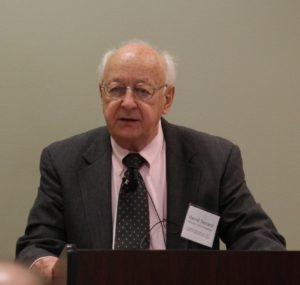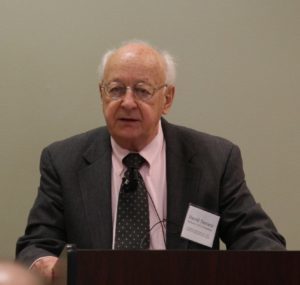

In the early 1960s, the parents of one of the authors left him [David R. Henderson, for those who are wondering], his brother, and his sister a lot. Such situations, with one pre-teen (the author) and two teenag- ers, can lead to a lot of conflict. On one issue, the three siblings figured out how to reduce conflict to zero by defining property rights. The family had a corn popper and all three liked popcorn. But there was a problem. Even when the three agreed on who was to pop the corn and who was to wash the resulting dishes (leaving no unwashed dishes was a strict household rule), each of the three had an incentive to eat quickly out of the common popcorn bowl so that he or she would get the popcorn ahead of his or her siblings. After only a few times in which all three ate popcorn more quickly than they ideally wanted to, they devised a solution. They poured the popcorn from the corn popper in equal amounts into three bowls. Then each had a bowl that was his or hers and each could take his/her sweet time eating. Problem solved. Tragedy of the commons averted. Harold Demsetz would have been proud.
When and why do property rights come about? It’s an important ques- tion but it was relatively unstudied by economists before the UCLA School got its hands on the issue. A pathbreaking article that gave an answer was Harold Demsetz’s 1967 “Toward a Theory of Property Rights” published in the American Economic Review.
Although economists are known to make unjustified fun of anthro- pologists, Demsetz took them seriously and read their literature. The specific area Demsetz studied was the development of property rights, or the lack of their development, among Aboriginal Canadians and native Americans. Anthropologist Frank G. Speck, wrote Demsetz, had “discovered that the Indians of the Labrador Peninsula had a long-established tradition of property in land.” The Speck article that Demsetz cited had been published way back in 1915. His finding was at odds with what anthropologists knew about Indians in the American Southwest. Anthropologist Eleanor Leacock, noting that dif- ference, inquired further into the situation of the Labrador Indians and wrote up her findings in 1954. According to Demsetz, “Leacock clearly established the fact that a close relationship existed, both historically and geographically, between the development of private rights in land and the development of the commercial fur trade” (1967: 351).
Reading Leacock’s article gave Demsetz his “aha” moment. He noted that although the factual basis of the correlation was solid, no theory that he knew of had related private property in land to the fact of the fur trade. But to Demsetz it seemed obvious. And in laying out his insight, Demsetz made a further contribution: he analyzed the tragedy of commons a full year and a half before the famous Science article, “The Tragedy of the Commons,” by biologist Garrett Hardin. The Hardin article had introduced the concept of the tragedy of the commons. The core idea is that if a commons, that is, an area that no one owns, is unmanaged, people will overuse it. If, for example, no one owns land on which cattle graze, and no one manages the land, cattle owners will overgraze the land and reduce its value. The Hardin article is one of the most-cited Science articles ever.
These are the opening paragraphs of “When Do Property Rights Come About?“, Chapter 4 of David R. Henderson and Steven Globerman, The Essential UCLA School of Economics, Fraser Institute, 2021.
The pic above is of Harold Demsetz. Here is his bio in David R. Henderson, ed., The Concise Encyclopedia of Economics.

READER COMMENTS
Jon Murphy
Aug 16 2021 at 7:29pm
Demsetz’s article is a great article in terms of style, too. It’s concise. It’s clear. There’s no need for fancy mathematics. It’s just very careful thinking.
Mark Brady
Aug 17 2021 at 2:36am
The biologist and eugenicist Garret Hardin!
Readers may be interested to learn that in his celebrated 1968 article, and also in his entry on “Tragedy of the Commons” in The Library of Economics and Liberty, Hardin gave credit to William Forster Lloyd (1794-1852). But it should be noted that Lloyd explained that it was an unmanaged common that was prone to overuse. See his Two Lectures on the Checks to Population (delivered in 1832 and first published in 1833). Later a repentant Hardin wrote a short article entitled “The Tragedy of the Unmanaged Commons” (1994).
Footnote. In his lecture “The Notion of Value” (1833, and first published in 1834) W. F. Lloyd anticipated the concept of diminishing marginal utility, nearly forty years before Jevons, Menger and Walras.
Jon Murphy
Aug 17 2021 at 7:50am
I hadn’t read his postscript “Tragedy of the Unmanaged Commons” before. Thanks for pointing it out. From an economist’s point of view, the postscript is a little weird. He seems to use the phrase “laissez-faire” to mean “without any rules whatsoever” which he then says is the dominant theory. Thus, “unmanaged,” becomes a byword for “chaotic.” But three things come quickly to mind:
First: Adam Smith (whom he cites as the father of laissez-faire) discussed at great length in all his writings and lectures the importance of rules, rights, and respect. Smith was a big proponent of institutional analysis.
Second: Adam Smith was not laissez-faire in the sense he means (or even in the more modern sense). Smith held a strong presumption of liberty, but that presumption could be overcome.
Third: Laissez-faire does not imply unmanaged as he discusses here. Indeed, Demsetz’s whole point is that property does become managed. It may be managed by government, but it doesn’t have to be. Elinor Ostrom has documented many cases of differing forms of management.
Mark Brady
Aug 17 2021 at 1:28pm
The reason for my post was to recognize William Forster Lloyd, who does not usually get credit for his discussion of the unmanaged commons in a thoughtful lecture on Malthus (1832). https://www.jstor.org/stable/1972412?origin=crossref&seq=1#metadata_info_tab_contents
Jon Murphy
Aug 17 2021 at 2:13pm
I figured as much. I was just commenting on the article you linked to.
David Henderson
Aug 17 2021 at 11:43am
Thanks, Mark. To be clear, though, the part of the Library of Economics and Liberty that has Hardin’s article is David R. Henderson, The Concise Encyclopedia of Economics. It’s here.
Comments are closed.